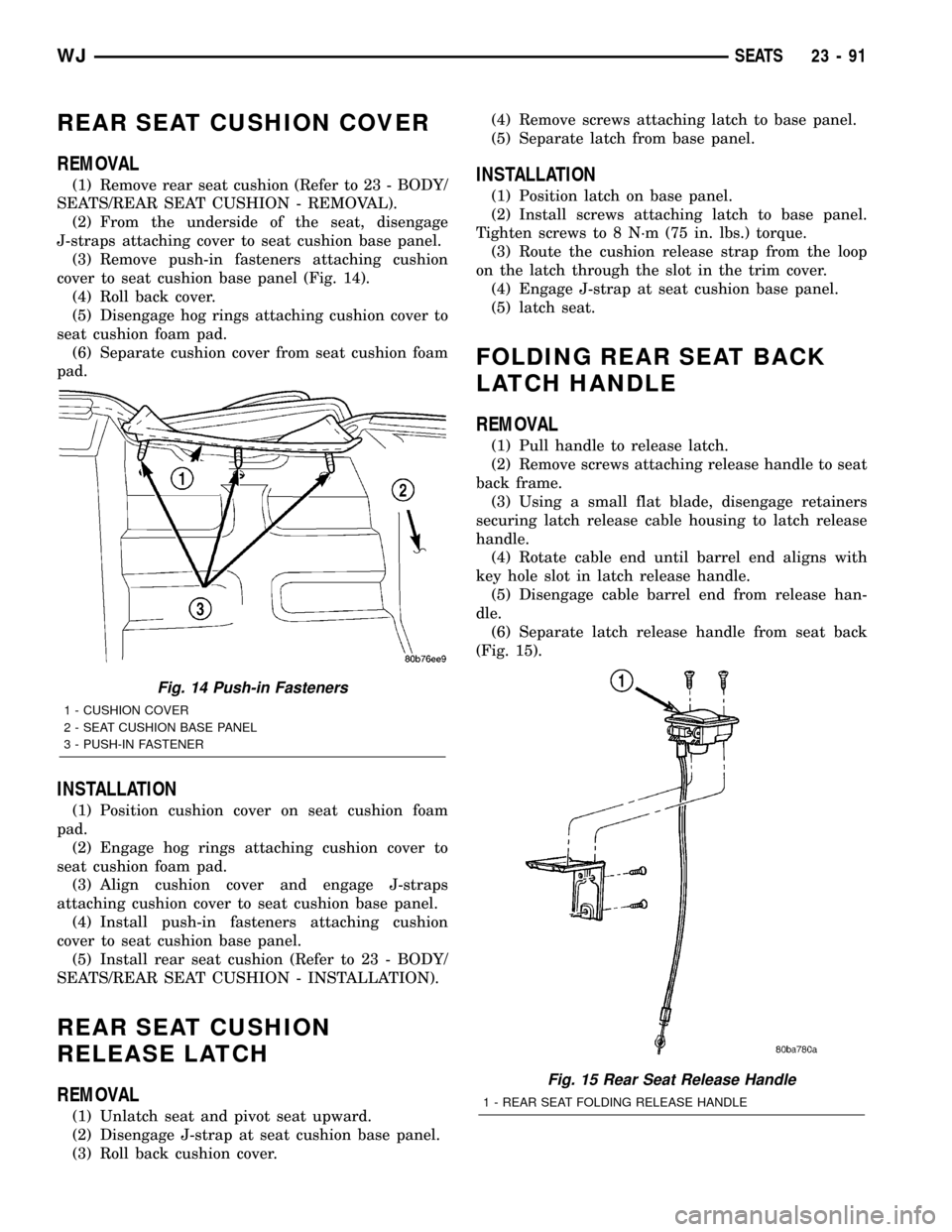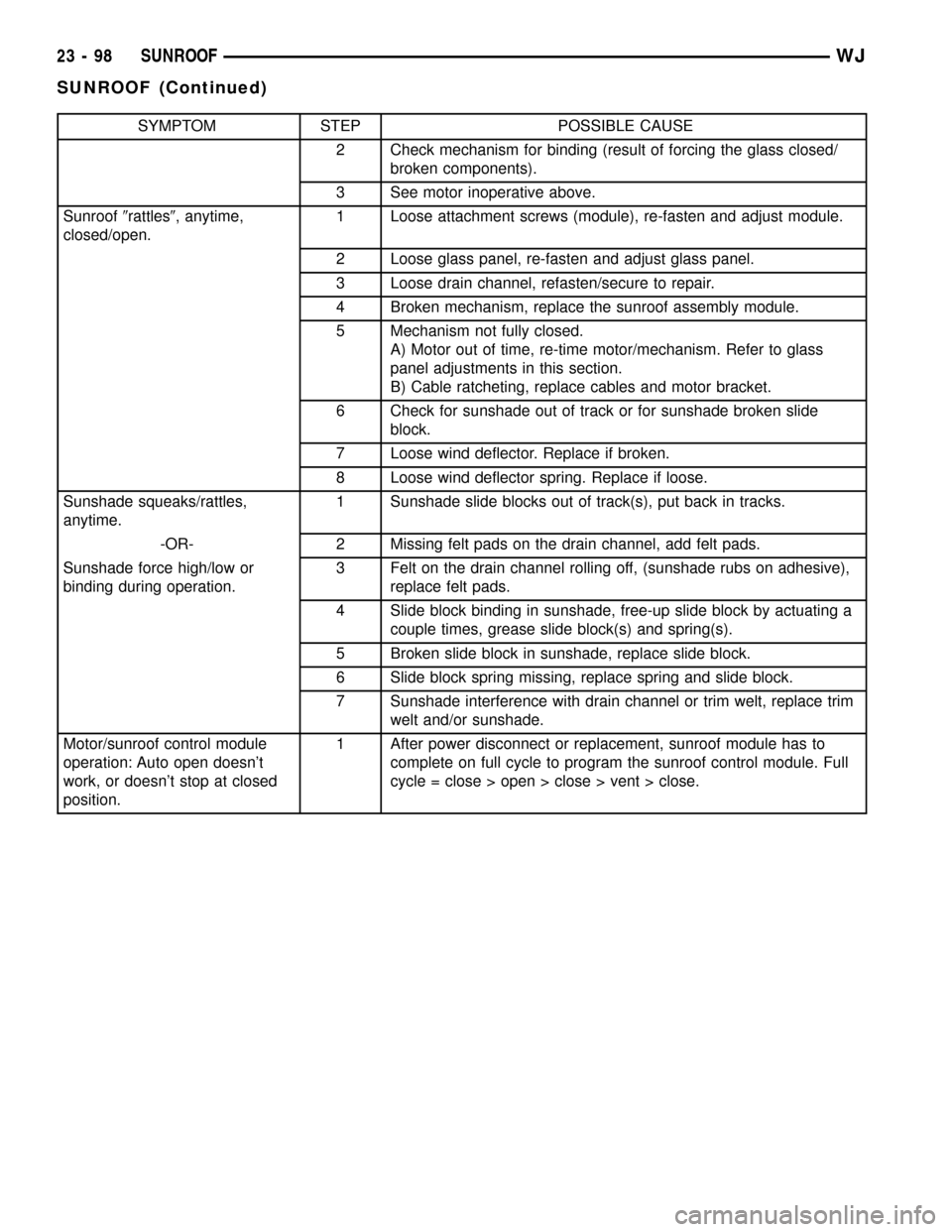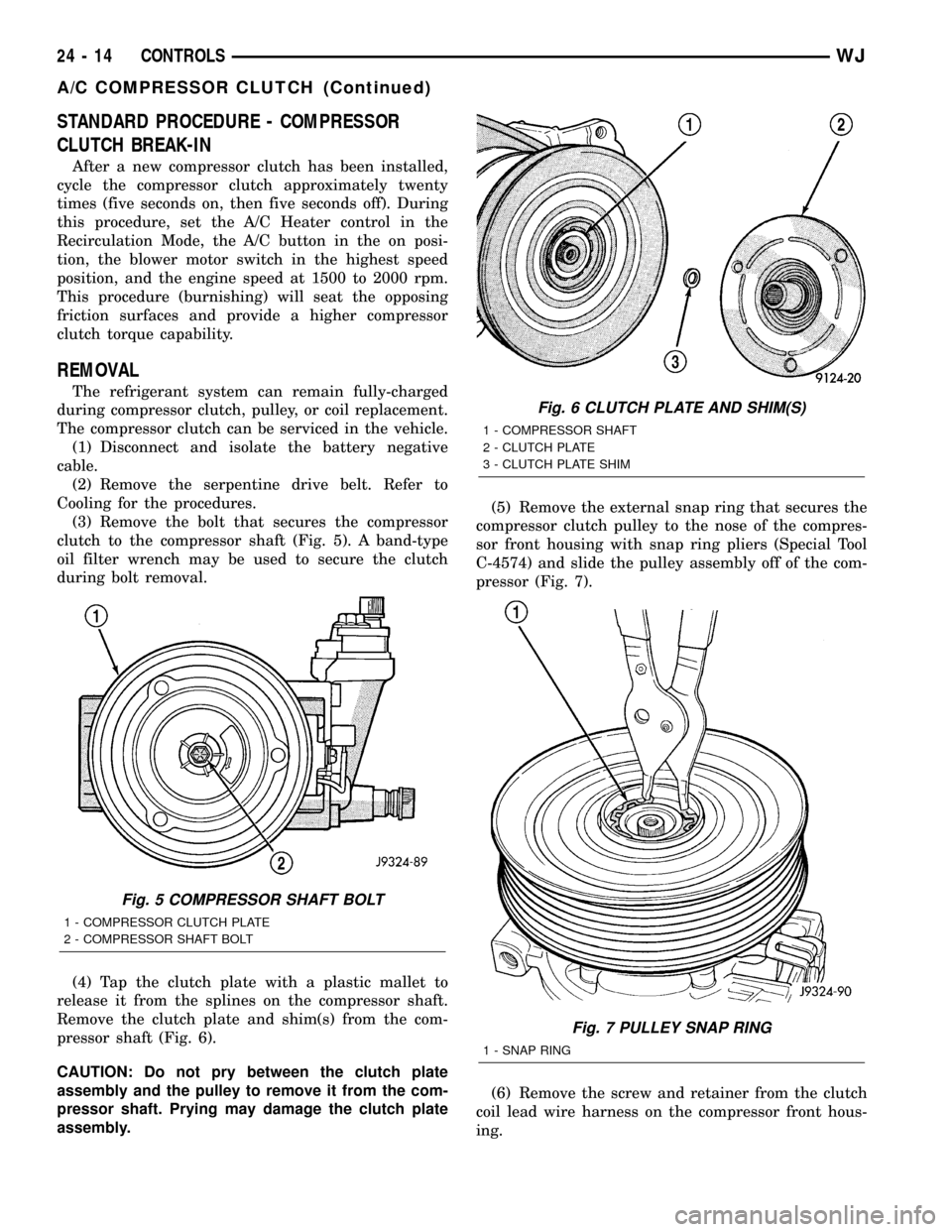2002 JEEP GRAND CHEROKEE ECU
[x] Cancel search: ECUPage 1959 of 2199

(8) Position head restraint release button caps on
head restraint sleeves and press to secure.
(9) Install head restraint (Refer to 23 - BODY/
SEATS/FRONT HEADREST - INSTALLATION).
FRONT SEAT CUSHION/COVER
REMOVAL
(1) Remove seat from vehicle (Refer to 23 - BODY/
SEATS/FRONT SEAT - REMOVAL).
(2) Remove seat back (Refer to 23 - BODY/SEATS/
FRONT SEAT BACK - REMOVAL).
(3) Disengage J-straps attaching cushion cover to
seat cushion frame.
(4) Disengage hog rings attaching cushion cover to
cushion frame at rear of seat along bottom of cushion
cover (Fig. 6).
(5) Roll up edges of cover and route seat function
switches through access hole on outboard side of seat
cushion, if equipped.
(6) Disengage seat cushion heater element connec-
tor, if equipped.
(7) Disengage hog rings attaching cover to cushion
along cover insert.
(8) Separate seat cushion cover from seat cushion.
INSTALLATION
(1) Position seat cover on cushion.
(2) Engage hog rings attaching cushion cover to
cushion along insert.
(3) Engage seat cushion heater element connector,
if equipped.
(4) Route seat function switches through access
hole on outboard side of seat cushion, if equipped.(5) Engage J-straps attaching cushion cover to seat
cushion frame.
(6) Engage hog rings attaching cushion cover to
cushion frame.
(7) Install seat back (Refer to 23 - BODY/SEATS/
FRONT SEAT BACK - INSTALLATION).
(8) Install seat (Refer to 23 - BODY/SEATS/
FRONT SEAT - INSTALLATION).
FRONT SEAT SIDE SHIELD
REMOVAL
(1) Remove screws attaching side shield to seat
frame.
(2) Disconnect wire harness connectors from power
seat and power lumbar switches, if equipped.
(3) Separate side shield from seat.
INSTALLATION
(1) Position side shield on seat.
(2) Connect wire harness connectors to power seat
and power lumbar switches, if equipped.
(3) Install screws attaching side shield to seat
frame.
SEAT TRACK & RECLINER
ASSEMBLY
REMOVAL
(1) Remove seat back (Refer to 23 - BODY/SEATS/
FRONT SEAT BACK - REMOVAL).
(2) Disengage J-strap at base of seat back.
(3) Roll seat back cover upward to access bolts
attaching recliner to seat back frame.
(4) Remove bolts attaching recliner to seat back
frame.
(5) Separate recliner from seat back.
INSTALLATION
(1) Position recliner on seat back.
(2) Install bolts attaching recliner to seat back
frame. Tighten bolts to 28 N´m (20 ft. lbs.) torque.
(3) Roll seat back cover downward.
(4) Engage J-strap at base of seat back.
(5) Install seat back (Refer to 23 - BODY/SEATS/
FRONT SEAT BACK - INSTALLATION).Fig. 6 Seat Cushion Cover
1 - HOG RING
2 - CUSHION COVER
23 - 86 SEATSWJ
FRONT SEAT BACK COVER (Continued)
Page 1961 of 2199

REAR HEADREST
REMOVAL
(1) Depress head rest release button and lift head
rest to full up position.
(2) Using a small flat blade, depress tab on out-
board side head rest release button and using your
hand, simultaneously press tab on inboard side head
rest release button (Fig. 9) and pull head rest up to
separate from seat back.
INSTALLATION
(1) Position head rest in seat back, press tab on
inboard side head rest release button cap and push
down head restraint to secure.
REAR HEADREST RELEASE
KNOB
REMOVAL
(1) Using a razor knife or equivalent, cut the
release knob from the release lever.
(2) Pull the release knob from the lever (Fig. 10).
INSTALLATION
(1) Position the release knob on the lever and
press to snap in place.
REAR HEADREST FOLDING
MECHANISM
REMOVAL
(1) Remove the head rest (Refer to 23 - BODY/
SEATS/REAR HEADREST - REMOVAL).
(2) Remove folding mechanism cover (Fig. 10).
(3) Remove the screws that secure the head rest
bun to the folding mechanism.
NOTE: The folding release knob is always located
on the outboard side.
INSTALLATION
(1) Position the head rest bun on the folding mech-
anism and install the screws.
(2) Install the folding mechanism cover.
(3) Install the head restraint (Refer to 23 - BODY/
SEATS/REAR HEADREST - INSTALLATION).
Fig. 9 Head Rest
1 - HEAD RESTRAINT
2 - FLAT BLADE
Fig. 10 Rear Seat Head Rest Folding Mechanism
1 - REAR SEAT HEAD REST FOLDING MECHANISM
2 - RELEASE KNOB
3 - FOLDING MECHANISM COVER
23 - 88 SEATSWJ
Page 1964 of 2199

REAR SEAT CUSHION COVER
REMOVAL
(1) Remove rear seat cushion (Refer to 23 - BODY/
SEATS/REAR SEAT CUSHION - REMOVAL).
(2) From the underside of the seat, disengage
J-straps attaching cover to seat cushion base panel.
(3) Remove push-in fasteners attaching cushion
cover to seat cushion base panel (Fig. 14).
(4) Roll back cover.
(5) Disengage hog rings attaching cushion cover to
seat cushion foam pad.
(6) Separate cushion cover from seat cushion foam
pad.
INSTALLATION
(1) Position cushion cover on seat cushion foam
pad.
(2) Engage hog rings attaching cushion cover to
seat cushion foam pad.
(3) Align cushion cover and engage J-straps
attaching cushion cover to seat cushion base panel.
(4) Install push-in fasteners attaching cushion
cover to seat cushion base panel.
(5) Install rear seat cushion (Refer to 23 - BODY/
SEATS/REAR SEAT CUSHION - INSTALLATION).
REAR SEAT CUSHION
RELEASE LATCH
REMOVAL
(1) Unlatch seat and pivot seat upward.
(2) Disengage J-strap at seat cushion base panel.
(3) Roll back cushion cover.(4) Remove screws attaching latch to base panel.
(5) Separate latch from base panel.
INSTALLATION
(1) Position latch on base panel.
(2) Install screws attaching latch to base panel.
Tighten screws to 8 N´m (75 in. lbs.) torque.
(3) Route the cushion release strap from the loop
on the latch through the slot in the trim cover.
(4) Engage J-strap at seat cushion base panel.
(5) latch seat.
FOLDING REAR SEAT BACK
LATCH HANDLE
REMOVAL
(1) Pull handle to release latch.
(2) Remove screws attaching release handle to seat
back frame.
(3) Using a small flat blade, disengage retainers
securing latch release cable housing to latch release
handle.
(4) Rotate cable end until barrel end aligns with
key hole slot in latch release handle.
(5) Disengage cable barrel end from release han-
dle.
(6) Separate latch release handle from seat back
(Fig. 15).
Fig. 14 Push-in Fasteners
1 - CUSHION COVER
2 - SEAT CUSHION BASE PANEL
3 - PUSH-IN FASTENER
Fig. 15 Rear Seat Release Handle
1 - REAR SEAT FOLDING RELEASE HANDLE
WJSEATS 23 - 91
Page 1965 of 2199

INSTALLATION
(1) Route cable end into latch release handle.
(2) Rotate cable end until barrel end aligns with
key hole slot in latch release handle and insert into
handle.
(3) Engage retainers securing latch release cable
housing to latch release handle.
(4) Position latch release handle in seat back.
Ensure seat back cover is properly aligned.
(5) Install screws attaching release handle to seat
back frame.
FOLDING REAR SEAT BACK
LATCH/HINGE
REMOVAL
(1) Remove seat back (Refer to 23 - BODY/SEATS/
REAR SEAT BACK - REMOVAL).
(2) Disengage J-straps on outboard side of seat
back.
(3) Disengage release cable from latch.
(4) Remove bolts attaching latch/hinge to seat back
frame.
(5) Separate latch/hinge from seat back frame.
INSTALLATION
(1) Position latch/hinge on seat back frame.
(2) Install bolts attaching latch/hinge to seat back
frame. Tighten bolts to 28 N´m (20 ft. lbs.) torque.
(3) Engage latch release cable.
(4) Engage J-straps on outboard side of seat back.
(5) Install seat back (Refer to 23 - BODY/SEATS/
REAR SEAT BACK - INSTALLATION).
23 - 92 SEATSWJ
FOLDING REAR SEAT BACK LATCH HANDLE (Continued)
Page 1971 of 2199

SYMPTOM STEP POSSIBLE CAUSE
2 Check mechanism for binding (result of forcing the glass closed/
broken components).
3 See motor inoperative above.
Sunroof9rattles9, anytime,
closed/open.1 Loose attachment screws (module), re-fasten and adjust module.
2 Loose glass panel, re-fasten and adjust glass panel.
3 Loose drain channel, refasten/secure to repair.
4 Broken mechanism, replace the sunroof assembly module.
5 Mechanism not fully closed.
A) Motor out of time, re-time motor/mechanism. Refer to glass
panel adjustments in this section.
B) Cable ratcheting, replace cables and motor bracket.
6 Check for sunshade out of track or for sunshade broken slide
block.
7 Loose wind deflector. Replace if broken.
8 Loose wind deflector spring. Replace if loose.
Sunshade squeaks/rattles,
anytime.1 Sunshade slide blocks out of track(s), put back in tracks.
-OR- 2 Missing felt pads on the drain channel, add felt pads.
Sunshade force high/low or
binding during operation.3 Felt on the drain channel rolling off, (sunshade rubs on adhesive),
replace felt pads.
4 Slide block binding in sunshade, free-up slide block by actuating a
couple times, grease slide block(s) and spring(s).
5 Broken slide block in sunshade, replace slide block.
6 Slide block spring missing, replace spring and slide block.
7 Sunshade interference with drain channel or trim welt, replace trim
welt and/or sunshade.
Motor/sunroof control module
operation: Auto open doesn't
work, or doesn't stop at closed
position.1 After power disconnect or replacement, sunroof module has to
complete on full cycle to program the sunroof control module. Full
cycle = close > open > close > vent > close.
23 - 98 SUNROOFWJ
SUNROOF (Continued)
Page 1973 of 2199

DRAIN TUBE
REMOVAL
(1) Remove the headliner. (Refer to 23 - BODY/IN-
TERIOR/HEADLINER - REMOVAL)
(2) Disengage clamps attaching drain tube to sun-
roof (Fig. 2).
(3) Tape the end of the old drain tube to the new
drain tube. Ensure that the tape build up on the tube
ends is not excessive.
(4) Remove front/rear trim panels as necessary to
disengage clamps securing drain tube to body.
(5) Remove the drain tube plug from the underside
of the vehicle.
(6) From the underside of the vehicle carefully,
pull/route the drain tube through the body panel.
Applying a soapy water solution to the new tube may
aid in this procedure.
INSTALLATION
(1) Install the plug adapter to the bottom of the
drain tube.
(2) Engage clamps securing drain tube to body
(Fig. 2).
(3) Install front/rear trim panels as necessary.
(4) Install drain tube to sunroof and engage clamp.
(5) Install the headliner. (Refer to 23 - BODY/IN-
TERIOR/HEADLINER - INSTALLATION)
Fig. 2 Sunroof Drain Hose Routing
1 - DRAIN HOSE
2 - CLAMPS
3 - PLUG
4 - FLOOR5 - CLAMPS
6 - DRAIN HOSE
23 - 100 SUNROOFWJ
Page 2090 of 2199

A/C COMPRESSOR CLUTCH
DESCRIPTION
The compressor clutch assembly consists of a sta-
tionary electromagnetic coil, a hub bearing and pul-
ley assembly, and a clutch plate (Fig. 4). The
electromagnetic coil unit and the hub bearing and
pulley assembly are each retained on the nose of the
compressor front housing with snap rings. The clutch
plate is keyed to the compressor shaft and secured
with a bolt.
OPERATION
The compressor clutch components provide the
means to engage and disengage the compressor from
the engine serpentine accessory drive belt. When the
clutch coil is energized, it magnetically draws the
clutch into contact with the pulley and drives the
compressor shaft. When the coil is not energized, the
pulley freewheels on the clutch hub bearing, which is
part of the pulley. The compressor clutch and coil are
the only serviced parts on the compressor.
The compressor clutch engagement is controlled by
several components: the a/c switch on the a/c heater
control panel, the Automatic Zone Control (AZC) con-
trol module (if the vehicle is so equipped), the evap-
orator probe, the a/c high pressure transducer, the
a/c compressor clutch relay, the body control module
(BCM) and the Powertrain Control Module (PCM).
The PCM may delay compressor clutch engagement
for up to thirty seconds. Refer to Electronic Control
Modules for more information on the PCM controls.
DIAGNOSIS AND TESTING - COMPRESSOR
CLUTCH COIL
For circuit descriptions and diagrams, refer to the
appropriate wiring diagrams. The battery must be
fully-charged before performing the following tests.
Refer to Battery for more information.
(1) Connect an ammeter (0 to 10 ampere scale) in
series with the clutch coil terminal. Use a voltmeter
(0 to 20 volt scale) with clip-type leads for measuring
the voltage across the battery and the compressor
clutch coil.
(2) With the a/c heater mode control switch in any
a/c mode, the a/c heater control a/c switch in the ON
position, and the blower motor switch in the lowest
speed position, start the engine and run it at normal
idle.
(3) The compressor clutch coil voltage should read
within 0.2 volts of the battery voltage. If there is
voltage at the clutch coil, but the reading is not
within 0.2 volts of the battery voltage, test the clutch
coil feed circuit for excessive voltage drop and repair
as required. If there is no voltage reading at the
clutch coil, use a DRBIIItscan tool and the appro-
priate diagnostic information for testing of the com-
pressor clutch circuit. The following components
must be checked and repaired as required before you
can complete testing of the clutch coil:
²Fuses in the junction block and the Power Dis-
tribution Center (PDC)
²A/C heater mode control switch
²A/C compressor clutch relay
²A/C high pressure transducer
²A/C evaporator probe
²Powertrain Control Module (PCM)
²Body Control Module (BCM)
(4) The compressor clutch coil is acceptable if the
current draw measured at the clutch coil is 2.0 to 3.9
amperes with the electrical system voltage at 11.5 to
12.5 volts. This should only be checked with the work
area temperature at 21É C (70É F). If system voltage
is more than 12.5 volts, add electrical loads by turn-
ing on electrical accessories until the system voltage
drops below 12.5 volts.
(a) If the clutch coil current reading is four
amperes or more, the coil is shorted and should be
replaced.
(b) If the clutch coil current reading is zero, the
coil is open and should be replaced.
Fig. 4 COMPRESSOR CLUTCH - TYPICAL
1 - CLUTCH PLATE
2 - SHAFT KEY
3 - PULLEY
4 - COIL
5 - CLUTCH SHIMS
6 - SNAP RING
7 - SNAP RING
WJCONTROLS 24 - 13
Page 2091 of 2199

STANDARD PROCEDURE - COMPRESSOR
CLUTCH BREAK-IN
After a new compressor clutch has been installed,
cycle the compressor clutch approximately twenty
times (five seconds on, then five seconds off). During
this procedure, set the A/C Heater control in the
Recirculation Mode, the A/C button in the on posi-
tion, the blower motor switch in the highest speed
position, and the engine speed at 1500 to 2000 rpm.
This procedure (burnishing) will seat the opposing
friction surfaces and provide a higher compressor
clutch torque capability.
REMOVAL
The refrigerant system can remain fully-charged
during compressor clutch, pulley, or coil replacement.
The compressor clutch can be serviced in the vehicle.
(1) Disconnect and isolate the battery negative
cable.
(2) Remove the serpentine drive belt. Refer to
Cooling for the procedures.
(3) Remove the bolt that secures the compressor
clutch to the compressor shaft (Fig. 5). A band-type
oil filter wrench may be used to secure the clutch
during bolt removal.
(4) Tap the clutch plate with a plastic mallet to
release it from the splines on the compressor shaft.
Remove the clutch plate and shim(s) from the com-
pressor shaft (Fig. 6).
CAUTION: Do not pry between the clutch plate
assembly and the pulley to remove it from the com-
pressor shaft. Prying may damage the clutch plate
assembly.(5) Remove the external snap ring that secures the
compressor clutch pulley to the nose of the compres-
sor front housing with snap ring pliers (Special Tool
C-4574) and slide the pulley assembly off of the com-
pressor (Fig. 7).
(6) Remove the screw and retainer from the clutch
coil lead wire harness on the compressor front hous-
ing.
Fig. 5 COMPRESSOR SHAFT BOLT
1 - COMPRESSOR CLUTCH PLATE
2 - COMPRESSOR SHAFT BOLT
Fig. 6 CLUTCH PLATE AND SHIM(S)
1 - COMPRESSOR SHAFT
2 - CLUTCH PLATE
3 - CLUTCH PLATE SHIM
Fig. 7 PULLEY SNAP RING
1 - SNAP RING
24 - 14 CONTROLSWJ
A/C COMPRESSOR CLUTCH (Continued)